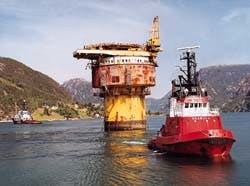The idled Brent spar has been moored in Erfjord near Stavanger since July 1995. Here, the water is deep enough to enable the derelict loading bouy to be dismantled vertically, unlike in the U.K. Photo courteesy of Shell U.K. Exploration and Production.After more than 2 years of highly public debate, Shell U.K. Exploration & Production has chosen a disposal plan for the Brent spar loading buoy.
The operator has decided to submit to the U.K. government a proposal by the Wood-GMC group of contractors to dismantle the spar's hull in a Norwegian fjord and use the pieces to build a quay extension.
The Wood-GMC proposal was one of six picked by Shell for detailed development from a list of 30 outline plans submitted by 19 contractors and consortia (OGJ, Jan. 20, 1997, p. 24).
Shell Expro, operating joint venture of Shell U.K. Ltd. and Esso Exploration & Production Ltd., set out to dump the derelict spar in deep water off northwestern Britain in 1995 but aborted the operation after protests.
Heinz Rothermund, managing director of Shell Expro, said, "We set out in 1995 to seek a solution at least as good as the deep sea disposal plan. We have not chosen deep sea disposal or onshore scrapping at any cost, as some urged.
"It is a unique re-use solution for a unique structure. Brent spar disposal will not set a precedent for other offshore structures. Every offshore installation is different, and disposal options need to be assessed on a case-by-case basis."
Wood-GMC plan
The Wood-GMC proposal is to raise the spar slowly in the water so that the hull can be sliced into rings, after topsides have been removed for scrapping.Wood-GMC is a joint venture of Wood Group plc, Aberdeen, and Maritime GMC AS, Stavanger. The venture's disposal plan cost then was estimated at £21.5 million ($34.5 million).
Shell said the full cost of the Wood-GMC disposal, including insurance, inspection and monitoring of the work, plus costs of the Shell management team, will bring the price to a total £23-26 million ($37-42 million).
The spar, currently moored in Erfjord near Stavanger, will be sandwiched between heavy lift barges. Then topsides will be removed for scrapping at a Norwegian yard.
The barges will be used to raise the hull vertically with jacked cables and a lifting cradle. As the hull is raised, it will be sliced into five main segments, each roughly 22 m high. The spar is 137 m high, including topsides, with a maximum diameter of 29 m. Total weight is 14,500 metric tons.
The segments will be skidded onto a barge for towing to Mekjarvik, near Stavanger. Here, the Stavanger Port Authority is building a quay extension for roll-on/roll-off ferries, due to be operational as of summer 1999.
Although the port authority intended to build the quay extension whether or not slices of Brent spar were available, re-use is expected to save £500,000 ($800,000) on quay materials costs.
Best option
Eric Faulds, Shell Expro's decommissioning manager, said the Wood-GMC proposal was the best in a benchmarking of waste, with 82% of the spar being re-used, 15% recycled, and only 3% scrapped."Having identified the best environmental option," said Faulds, "we then checked the six shortlisted proposals for safety considerations and then we compared costs (OGJ, Oct. 27, 1997, p. 34).
"On safety, a proposal by AMEC had the highest risk, while deep sea disposal had the lowest. The others, including Wood-GMC, were comparable with day-to-day North Sea operations."
What's next
Faulds said the government required Shell to confirm its choice of disposal plan through an independent consultant before submitting a request for approval.He said Shell hopes to be given a green light from government for the Wood-GMC plan in the summer. If the approval is not received then, the spar slices will not be ready to meet the quay construction schedule.
Immediately after Shell announced its disposal plan, U.K. Energy Minister John Battle said that the Natural Environment Research Council (NERC) had been asked to check the disposal plan.
The U.K. Department of Trade and Industry (DTI) said NERC's charge is to examine the science and potential environmental effects of Shell's proposal, taking into account engineering considerations.
"The group will provide a scientific appraisal of the option," said DTI. "It will also consult widely within the scientific community and with other interested parties. It is expected to report on the new disposal option in May."
Greenpeace, Ukooa views
The environmental campaign group Greenpeace, which instigated the protests that led Shell to abandon its plans to dump the spar, welcomed the new disposal plan (see Watching the World, p. 31).
The green crusaders said Shell should accept that dumping at sea is wrong in principle and unnecessary in practice: "Greenpeace believes the way is now clear for a permanent ban on the dumping of decommissioned offshore installations in the ocean."
U.K. Offshore Operators Association (Ukooa) echoed Rothermund's opinion that the Brent spar disposal should not be taken as a precedent for abandonment of other offshore installations.
Ukooa contends that the Brent spar is unique and that it continues to support the view, also supported by government, that disposal of deepwater installations should be taken after case-by-case assessments.
James May, director general of Ukooa, said, "The process undergone for Brent spar supports a case-by-case approach. Each structure is different and is built for a particular set of circumstances.
"It is unrealistic to have a generic solution for disposal of all offshore oil and gas installations. We need to maintain flexibility in the regulatory process so that the best solution can be reached for each structure."
Copyright 1997 Oil & Gas Journal. All Rights Reserved.



